Abstract
1. Adrenaline-induced arrhythmias in anaesthetized dogs respired with halothane were attenuated in 3 groups of 6 dogs by either UK-52046, 3.8 +/- 1.4 micrograms kg-1 (mean +/- s.e.mean), atenolol 14.6 +/- 2.1 micrograms kg-1, or a combination containing equal amounts of the two drugs of 0.36 +/- 0.1 microgram kg-1. The pressor response to adrenaline was reduced (P less than 0.01) by UK-52046 but not by atenolol or the combination of both drugs. 2. In a group of 6 dogs with multiventricular ectopic beats 24 h after coronary artery ligation (CAL), UK-52046, 32 micrograms kg-1, increased the number of sinus beats in each 5 min period from 137 +/- 47 to 662 +/- 99 (P less than 0.01); this was associated with a significant (P less than 0.01) fall in blood pressure. Atenolol in doses of up to 800 micrograms kg-1 had no effect. 3. UK-52046, 3.7 +/- 1.4 micrograms kg-1, prevented adrenaline-induced arrhythmias 3-4 days after CAL in 6/6 conscious dogs; atenolol in doses of up to 100 micrograms kg-1 produced an 84.4 +/- 7.4% reduction in the number of ventricular ectopic beats. A combination containing 3.7 +/- 1.1 micrograms kg-1 of each drug prevented the arrhythmia in 6/6 dogs. The pressor response to adrenaline was attenuated (P less than 0.05) by UK-52046, but resting blood pressure was unaffected by the different treatments. An increase (P less than 0.01) in heart rate was associated with both UK-52046 and the combination. 4. Neither UK-52046 (doses up to 64 micrograms kg-1) nor atenolol (up to 800 micrograms kg-1) had any effect upon ouabain-induced arrhythmias in 2 groups of 6 anaesthetized dogs. 5. In a study of the early (1a/1b) arrhythmias of acute myocardial ischaemia, the total number of ventricular ectopic beats occurring within 30 min of CAL was not reduced by 4 micrograms kg-1 UK-52046 but fell (P less than 0.01 compared with placebo) after 8 micrograms kg-1 [median values with ranges for placebo, 4 micrograms kg-1 and 8 micrograms kg-1 respectively 190 (4-674), 246 (9-1204) and 12 (1-154)]. Both doses of UK-52046 were associated with significant falls in blood pressure. 6. The arrhythmias produced by programmed electrical stimulation were studied in 2 groups of 6 conscious dogs, 7-30 days after CAL. With placebo, 4/6 dogs remained unchanged and 2 died: UK-52046 prevented arrhythmias in 2/6, 2 remained unchanged and 2 died (P = 0.29).(ABSTRACT TRUNCATED AT 400 WORDS)
Full text
PDF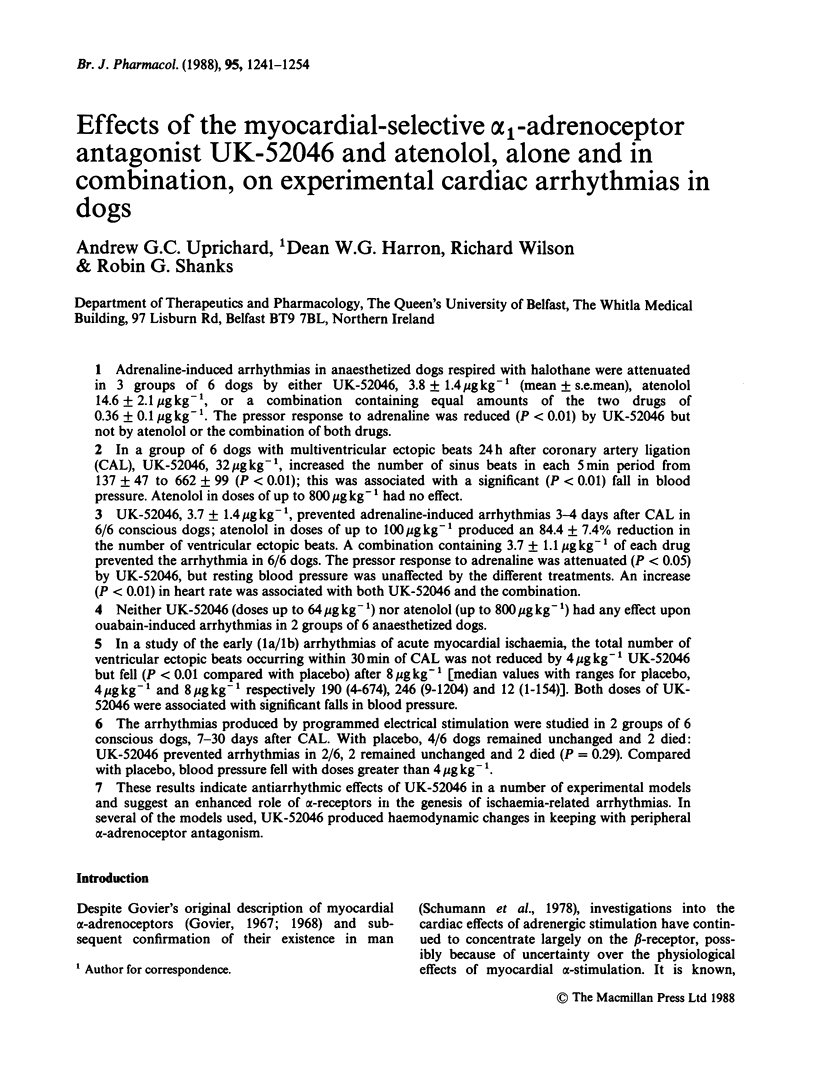
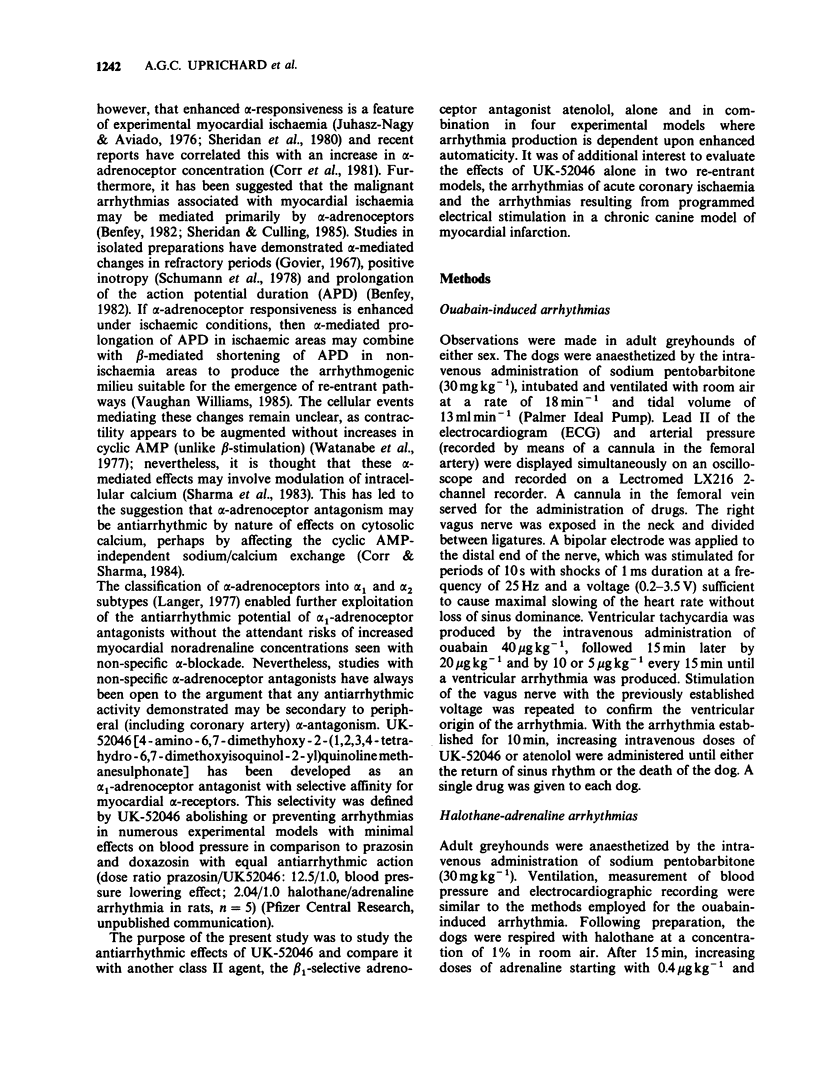
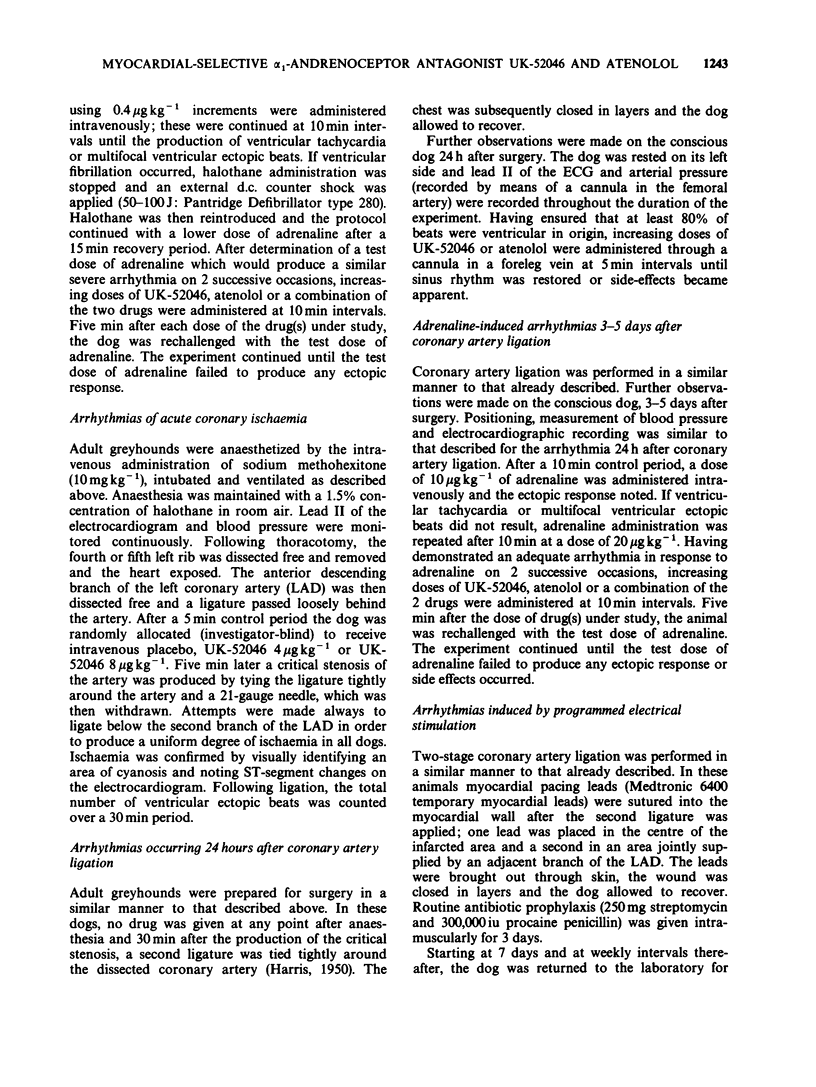
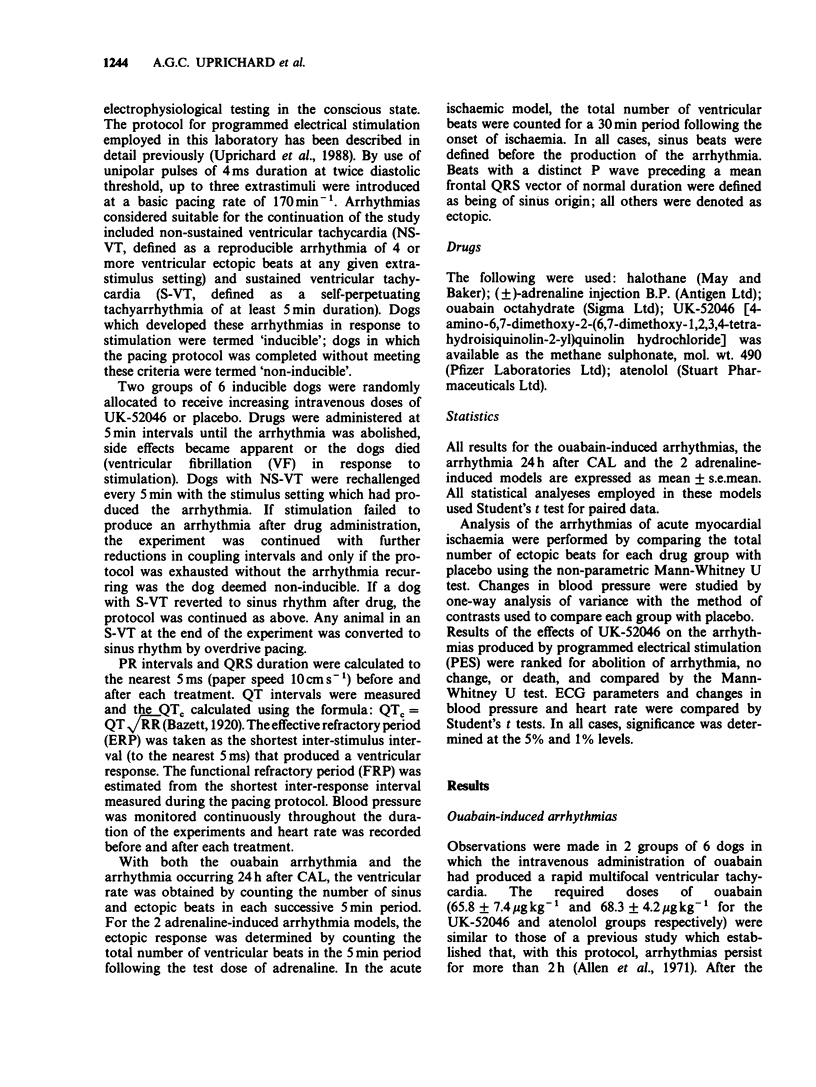
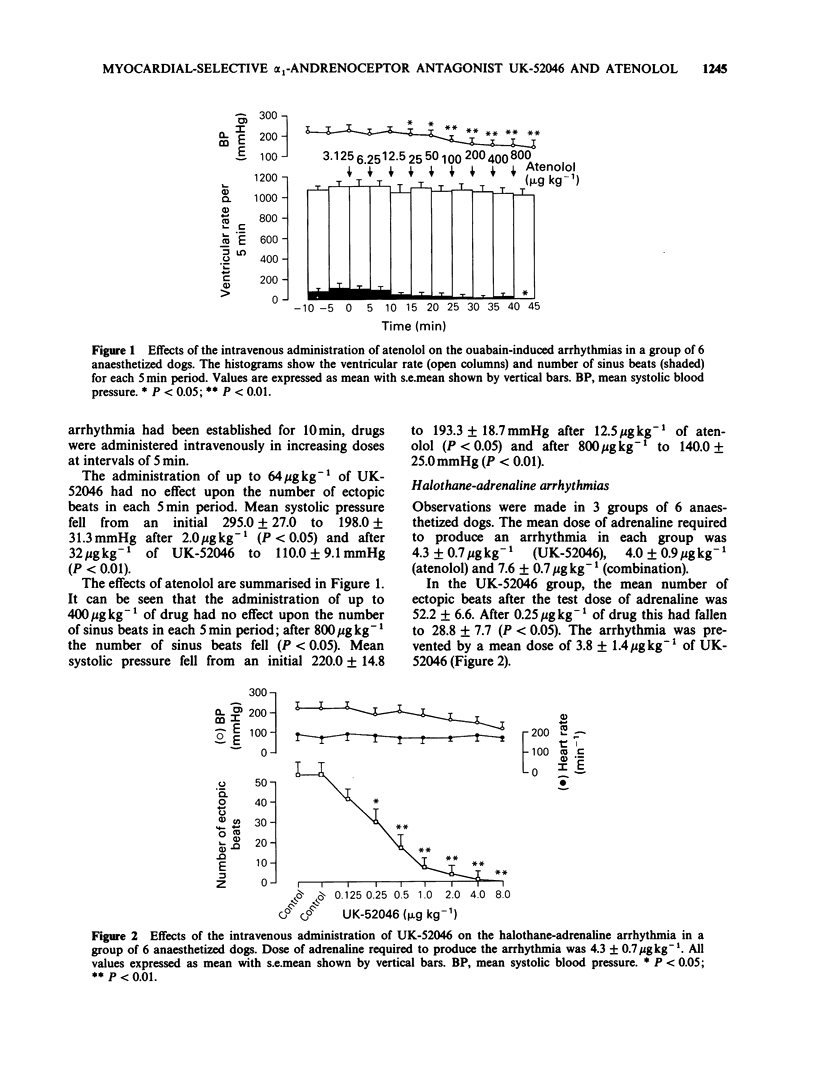
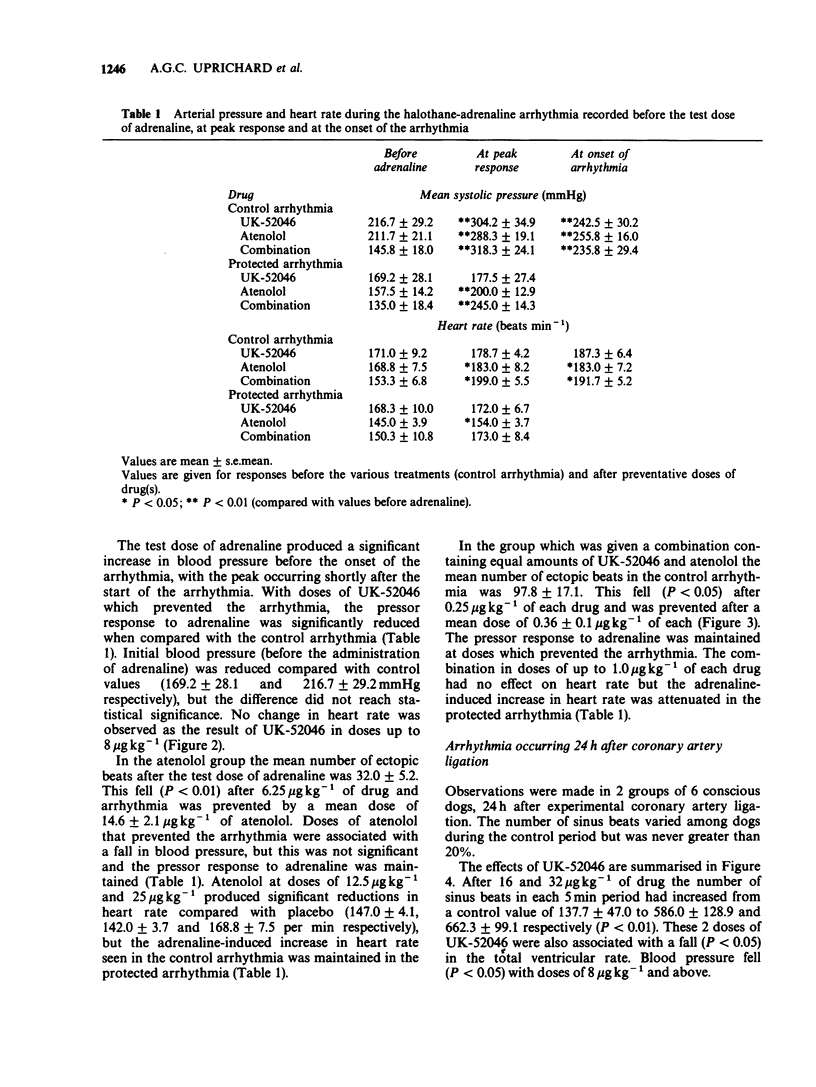
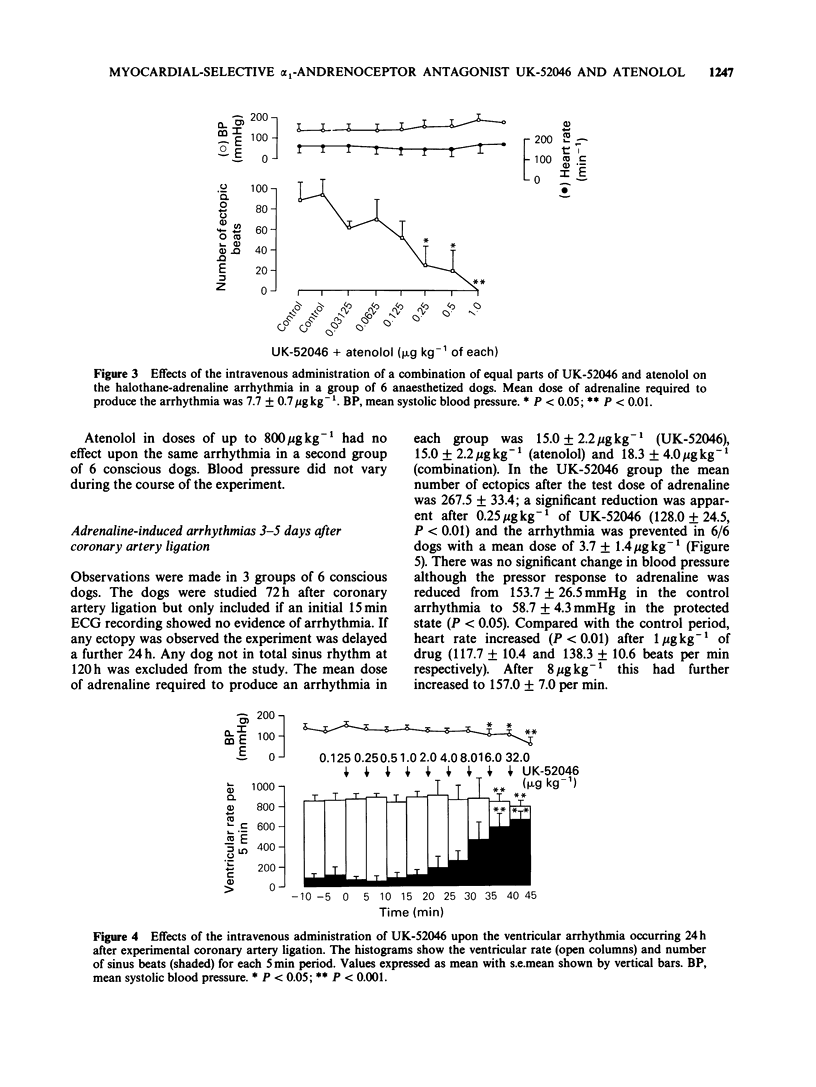
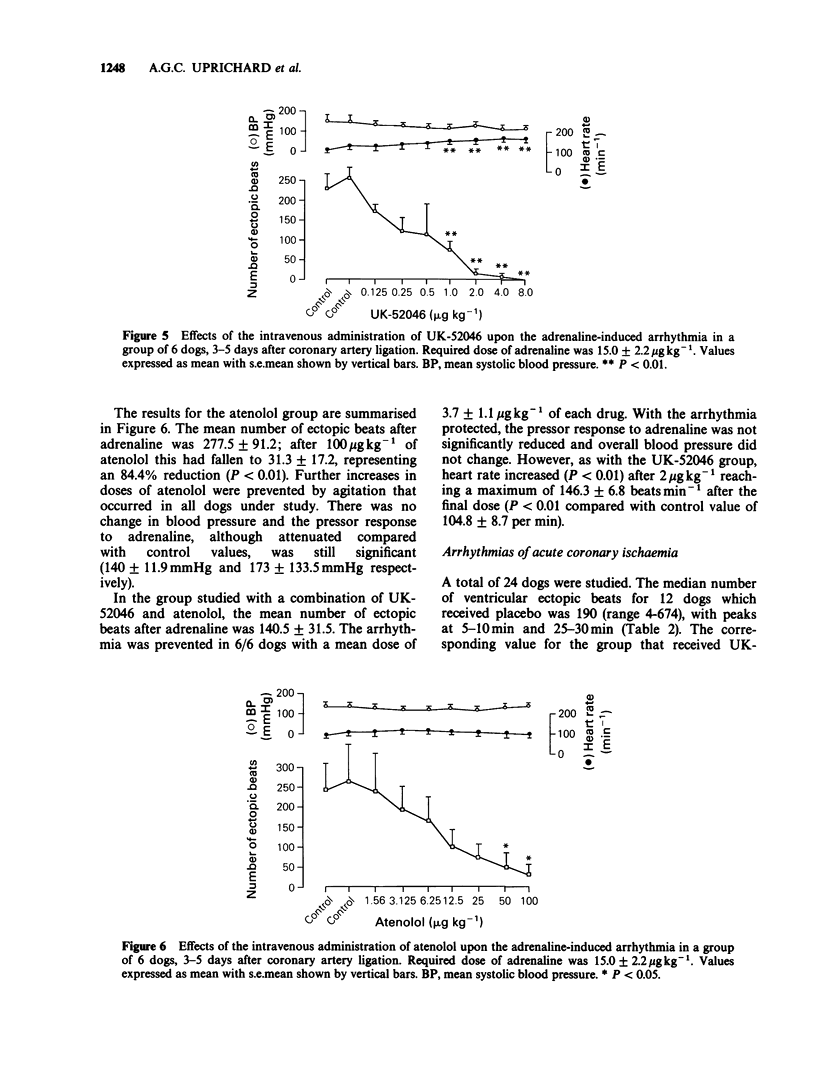
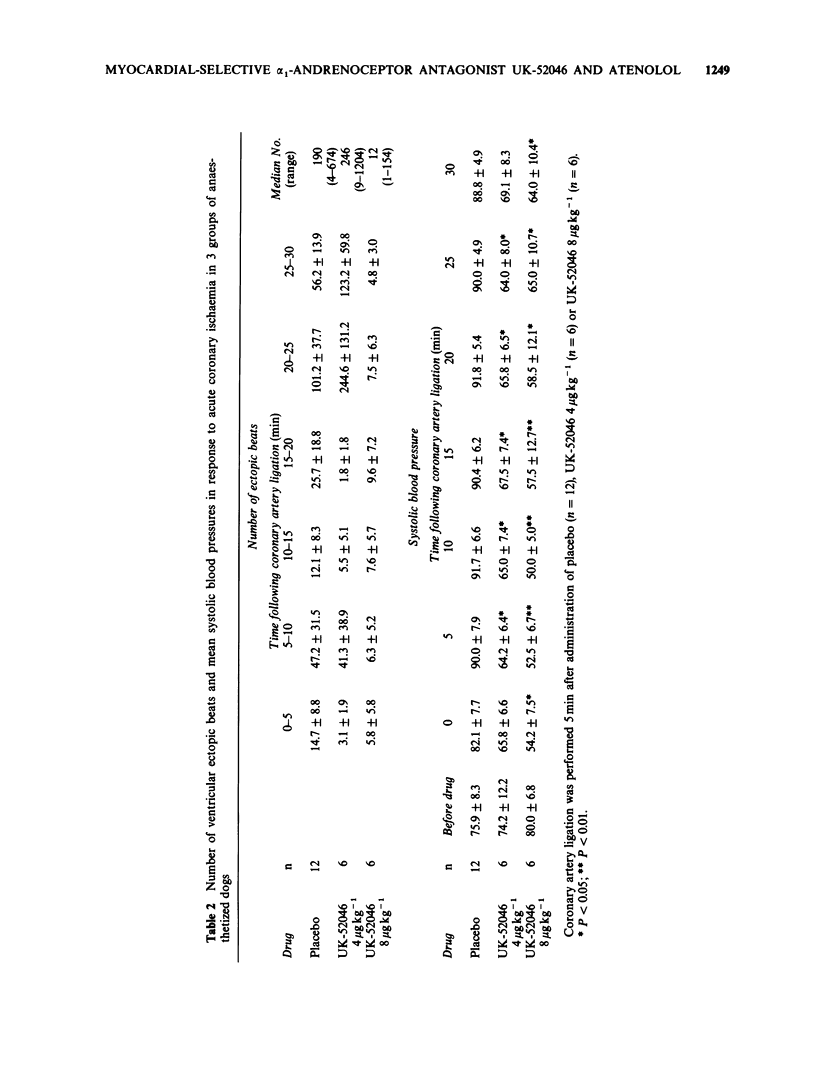
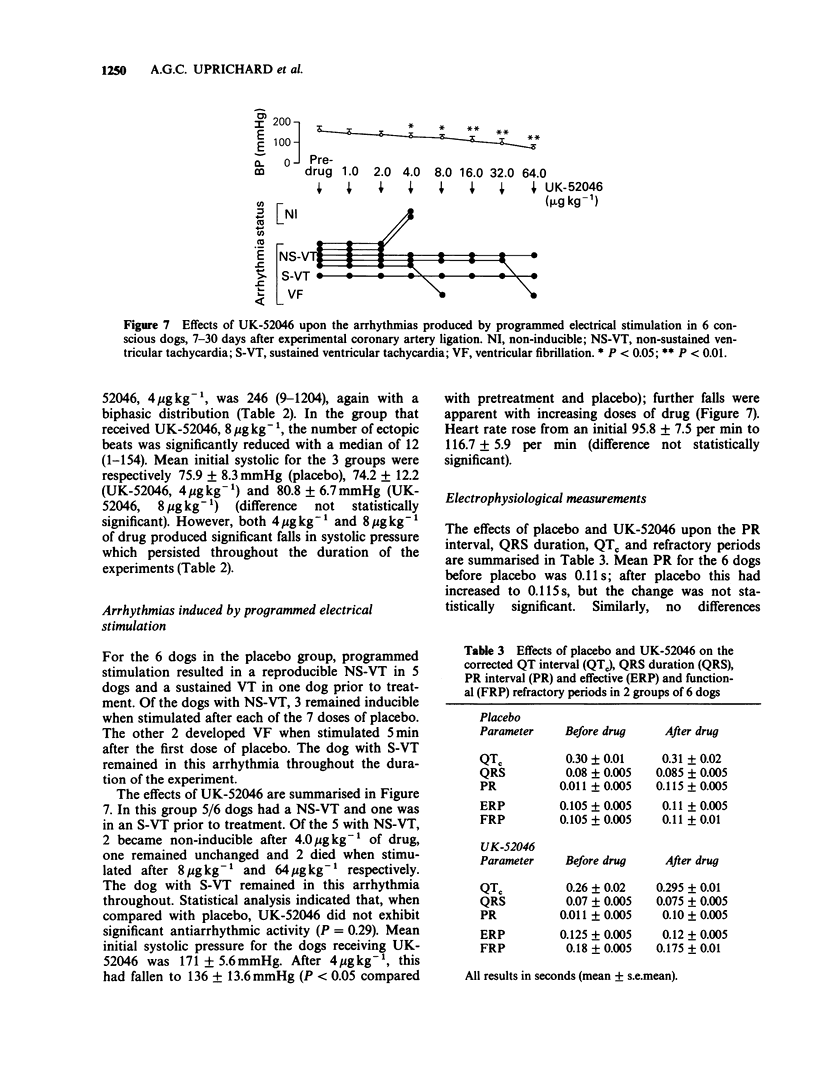
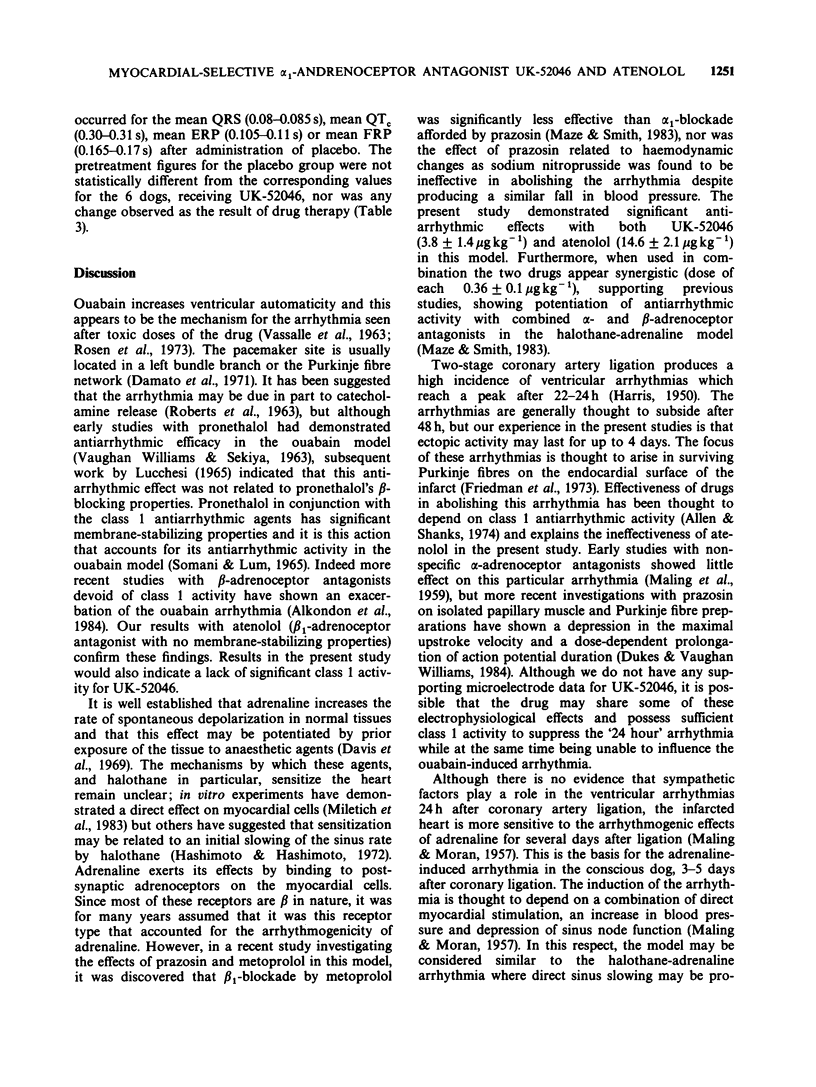
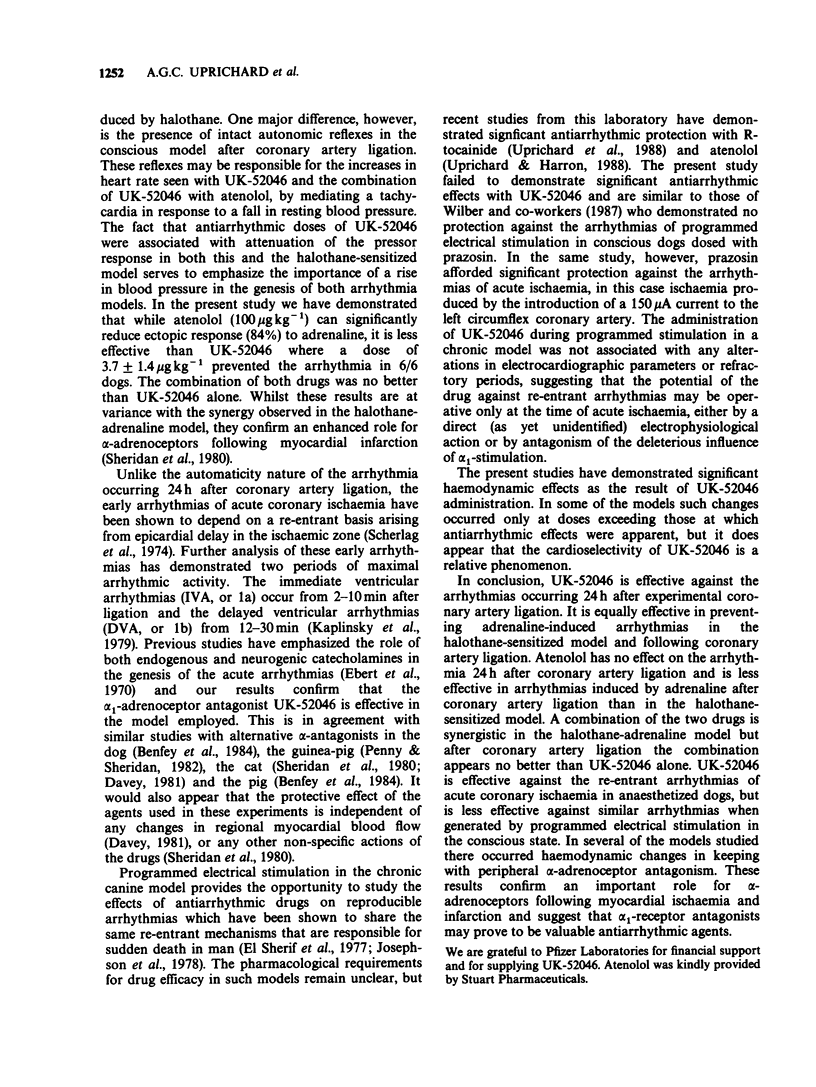
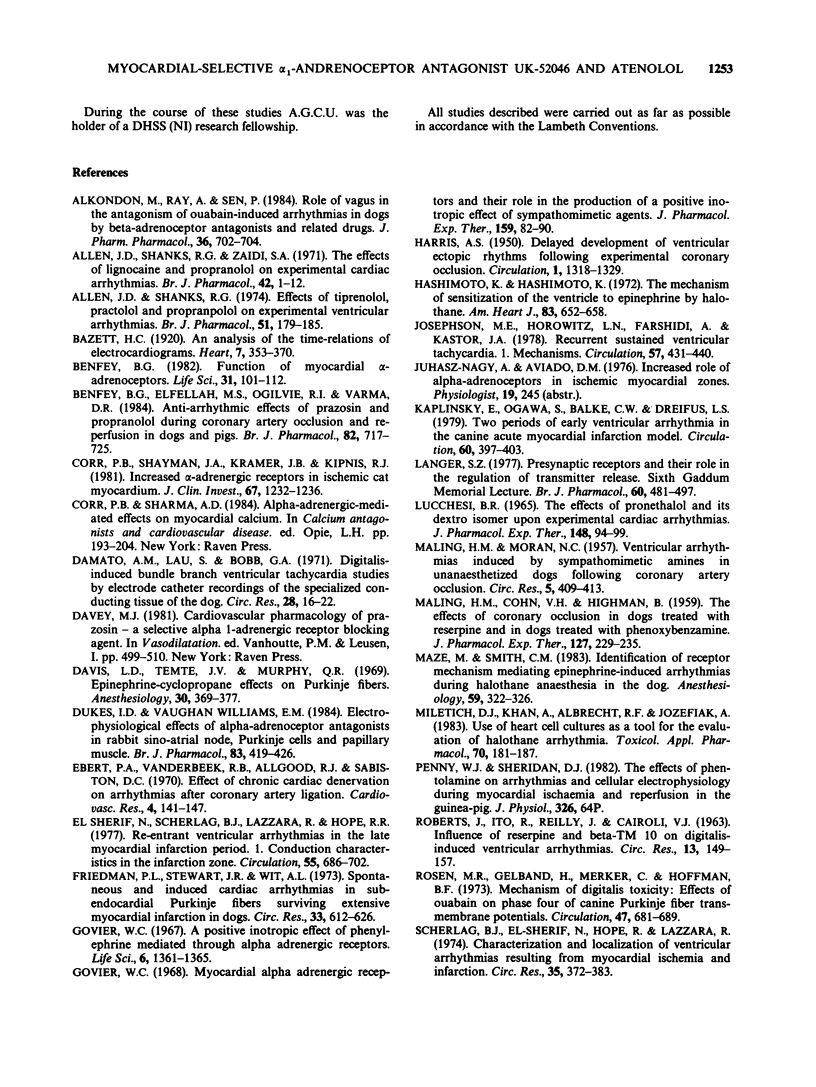
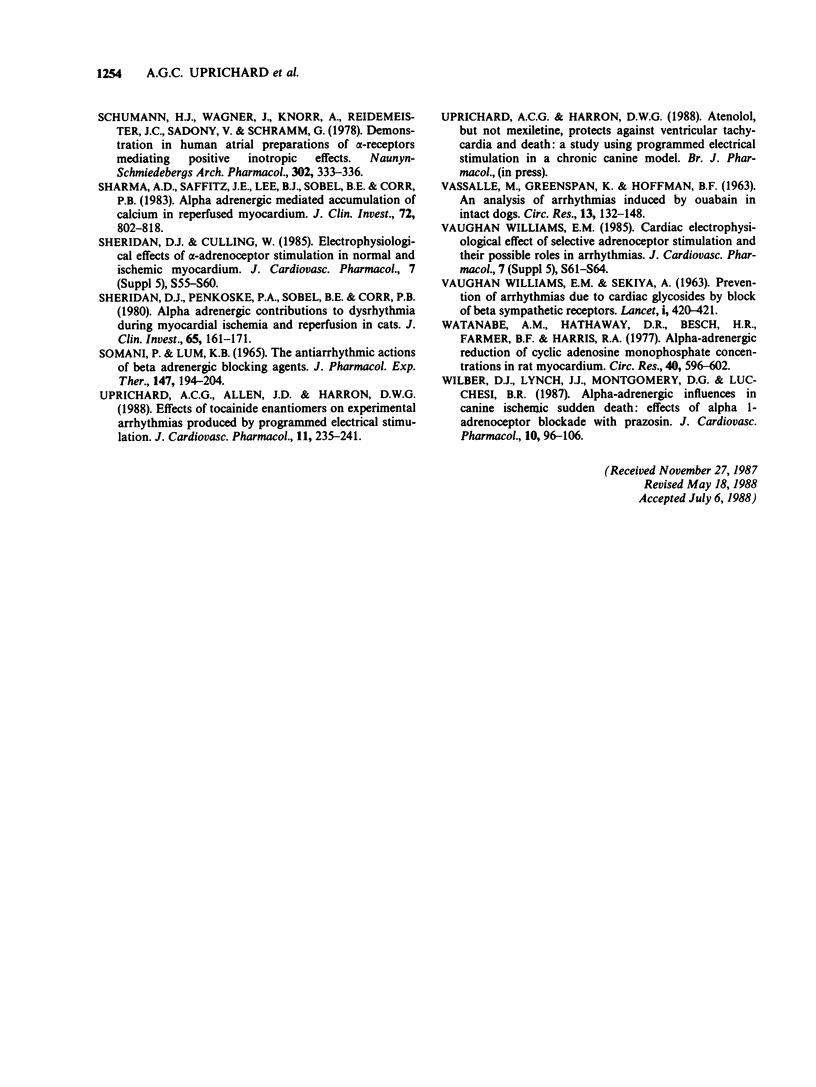
Selected References
These references are in PubMed. This may not be the complete list of references from this article.
- Alkondon M., Ray A., Sen P. Role of vagus in the antagonism of ouabain induced arrhythmias in dogs by beta-adrenoceptor antagonists and related drugs. J Pharm Pharmacol. 1984 Oct;36(10):702–704. doi: 10.1111/j.2042-7158.1984.tb04851.x. [DOI] [PubMed] [Google Scholar]
- Allen J. D., Shanks R. G. Effects of tiprenolol, practolol and propranolol on experimental ventricular tachyarrhythmias. Br J Pharmacol. 1974 Jun;51(2):179–185. doi: 10.1111/j.1476-5381.1974.tb09645.x. [DOI] [PMC free article] [PubMed] [Google Scholar]
- Allen J. D., Shanks R. G., Zaidi S. A. Effects of lignocaine and propranolol on experimental cardiac arrhythmias. Br J Pharmacol. 1971 May;42(1):1–12. doi: 10.1111/j.1476-5381.1971.tb07081.x. [DOI] [PMC free article] [PubMed] [Google Scholar]
- Benfey B. G., Elfellah M. S., Ogilvie R. I., Varma D. R. Anti-arrhythmic effects of prazosin and propranolol during coronary artery occlusion and re-perfusion in dogs and pigs. Br J Pharmacol. 1984 Jul;82(3):717–725. doi: 10.1111/j.1476-5381.1984.tb10811.x. [DOI] [PMC free article] [PubMed] [Google Scholar]
- Benfey B. G. Function of myocardial alpha-adrenoceptors. Life Sci. 1982 Jul 12;31(2):101–112. doi: 10.1016/0024-3205(82)90421-0. [DOI] [PubMed] [Google Scholar]
- Corr P. B., Shayman J. A., Kramer J. B., Kipnis R. J. Increased alpha-adrenergic receptors in ischemic cat myocardium. A potential mediator of electrophysiological derangements. J Clin Invest. 1981 Apr;67(4):1232–1236. doi: 10.1172/JCI110139. [DOI] [PMC free article] [PubMed] [Google Scholar]
- Damato A. N., Lau S. H., Bobb G. A. Digitalis-induced bundle-branch ventricular tachycardia studied by electrode catheter recordings of the specialized conducting tissues of the dog. Circ Res. 1971 Jan;28(1):16–22. doi: 10.1161/01.res.28.1.16. [DOI] [PubMed] [Google Scholar]
- Davis L. D., Temte J. V., Murphy Q. R. Epinephrine--cyclopropane effects on Purkinje fibers. Anesthesiology. 1969 Apr;30(4):369–377. doi: 10.1097/00000542-196904000-00004. [DOI] [PubMed] [Google Scholar]
- Dukes I. D., Vaughan Williams E. M. Electrophysiological effects of alpha-adrenoceptor antagonists in rabbit sino-atrial node, cardiac Purkinje cells and papillary muscles. Br J Pharmacol. 1984 Oct;83(2):419–426. doi: 10.1111/j.1476-5381.1984.tb16502.x. [DOI] [PMC free article] [PubMed] [Google Scholar]
- Ebert P. A., Vanderbeek R. B., Allgood R. J., Sabiston D. C., Jr Effect of chronic cardiac denervation on arrhythmias after coronary artery ligation. Cardiovasc Res. 1970 Apr;4(2):141–147. doi: 10.1093/cvr/4.2.141. [DOI] [PubMed] [Google Scholar]
- El-Sherif N., Hope R. R., Scherlag B. J., Lazzara R. Re-entrant ventricular arrhythmias in the late myocardial infarction period. 2. Patterns of initiation and termination of re-entry. Circulation. 1977 May;55(5):702–719. doi: 10.1161/01.cir.55.5.702. [DOI] [PubMed] [Google Scholar]
- Friedman P. L., Stewart J. R., Wit A. L. Spontaneous and induced cardiac arrhythmias in subendocardial Purkinje fibers surviving extensive myocardial infarction in dogs. Circ Res. 1973 Nov;33(5):612–626. doi: 10.1161/01.res.33.5.612. [DOI] [PubMed] [Google Scholar]
- Govier W. C. A positive inotropic effect of phenylephrine mediated through alpha adrenergic receptors. Life Sci. 1967 Jul 1;6(13):1361–1365. doi: 10.1016/0024-3205(67)90182-8. [DOI] [PubMed] [Google Scholar]
- Govier W. C. Myocardial alpha adrenergic receptors and their role in the production of a positive inotropic effect by sympathomimetic agents. J Pharmacol Exp Ther. 1968 Jan;159(1):82–90. [PubMed] [Google Scholar]
- HARRIS A. S. Delayed development of ventricular ectopic rhythms following experimental coronary occlusion. Circulation. 1950 Jun;1(6):1318–1328. doi: 10.1161/01.cir.1.6.1318. [DOI] [PubMed] [Google Scholar]
- Hashimoto K., Hashimoto K. The mechanism of sensitization of the ventricle to epinephrine by halothane. Am Heart J. 1972 May;83(5):652–658. doi: 10.1016/0002-8703(72)90405-x. [DOI] [PubMed] [Google Scholar]
- Josephson M. E., Horowitz L. N., Farshidi A., Kastor J. A. Recurrent sustained ventricular tachycardia. 1. Mechanisms. Circulation. 1978 Mar;57(3):431–440. doi: 10.1161/01.cir.57.3.431. [DOI] [PubMed] [Google Scholar]
- Kaplinsky E., Ogawa S., Balke C. W., Dreifus L. S. Two periods of early ventricular arrhythmia in the canine acute myocardial infarction model. Circulation. 1979 Aug;60(2):397–403. doi: 10.1161/01.cir.60.2.397. [DOI] [PubMed] [Google Scholar]
- LUCCHESI B. R. THE EFFECTS OF PRONETHALOL AND ITS DEXTRO ISOMER UPON EXPERIMENTAL CARDIAC ARRHYTHMIAS. J Pharmacol Exp Ther. 1965 Apr;148:94–99. [PubMed] [Google Scholar]
- Langer S. Z. Sixth gaddum memorial lecture, National Institute for Medical Research, Mill Hill, January 1977. Presynaptic receptors and their role in the regulation of transmitter release. Br J Pharmacol. 1977 Aug;60(4):481–497. doi: 10.1111/j.1476-5381.1977.tb07526.x. [DOI] [PMC free article] [PubMed] [Google Scholar]
- MALING H. M., COHN V. H., Jr, HIGHMAN B. The effects of coronary occlusion in dogs treated with reserpine and in dogs treated with phenoxybenzamine. J Pharmacol Exp Ther. 1959 Nov;127:229–235. [PubMed] [Google Scholar]
- MALING H. M., MORAN N. C. Ventricular arrhythmias induced by sympathomimetic amines in unanesthetized dogs following coronary artery occlusion. Circ Res. 1957 Jul;5(4):409–413. doi: 10.1161/01.res.5.4.409. [DOI] [PubMed] [Google Scholar]
- Maze M., Smith C. M. Identification of receptor mechanism mediating epinephrine-induced arrhythmias during halothane anesthesia in the dog. Anesthesiology. 1983 Oct;59(4):322–326. doi: 10.1097/00000542-198310000-00009. [DOI] [PubMed] [Google Scholar]
- Miletich D. J., Khan A., Albrecht R. F., Jozefiak A. Use of heart cell cultures as a tool for the evaluation of halothane arrhythmia. Toxicol Appl Pharmacol. 1983 Sep 15;70(2):181–187. doi: 10.1016/0041-008x(83)90093-5. [DOI] [PubMed] [Google Scholar]
- ROBERTS J., ITO R., REILLY J., CAIROLI V. J. INFLUENCE OF RESERPINE AND BETA TM 10 ON DIGITALIS-INDUCED VENTRICULAR ARRHYTHMIA. Circ Res. 1963 Aug;13:149–158. doi: 10.1161/01.res.13.2.149. [DOI] [PubMed] [Google Scholar]
- Rosen M. R., Gelband H., Merker C., Hoffman B. F. Mechanisms of digitalis toxicity. Effects of ouabain on phase four of canine Purkinje fiber transmembrane potentials. Circulation. 1973 Apr;47(4):681–689. doi: 10.1161/01.cir.47.4.681. [DOI] [PubMed] [Google Scholar]
- SOMANI P., LUM B. K. THE ANTIARRHYTHMIC ACTIONS OF BETA ADRENERGIC BLOCKING AGENTS. J Pharmacol Exp Ther. 1965 Feb;147:194–204. [PubMed] [Google Scholar]
- Scherlag B. J., el-Sherif N., Hope R., Lazzara R. Characterization and localization of ventricular arrhythmias resulting from myocardial ischemia and infarction. Circ Res. 1974 Sep;35(3):372–383. doi: 10.1161/01.res.35.3.372. [DOI] [PubMed] [Google Scholar]
- Schümann H. J., Wagner J., Knorr A., Reidemeister J. C., Sadony V., Schramm G. Demonstration in human atrial preparations of alpha-adrenoceptors mediating positive inotropic effects. Naunyn Schmiedebergs Arch Pharmacol. 1978 May;302(3):333–336. doi: 10.1007/BF00508304. [DOI] [PubMed] [Google Scholar]
- Sharma A. D., Saffitz J. E., Lee B. I., Sobel B. E., Corr P. B. Alpha adrenergic-mediated accumulation of calcium in reperfused myocardium. J Clin Invest. 1983 Sep;72(3):802–818. doi: 10.1172/JCI111051. [DOI] [PMC free article] [PubMed] [Google Scholar]
- Sheridan D. J., Culling W. Electrophysiological effects of alpha-adrenoceptor stimulation in normal and ischemic myocardium. J Cardiovasc Pharmacol. 1985;7 (Suppl 5):S55–S60. doi: 10.1097/00005344-198500075-00012. [DOI] [PubMed] [Google Scholar]
- Sheridan D. J., Penkoske P. A., Sobel B. E., Corr P. B. Alpha adrenergic contributions to dysrhythmia during myocardial ischemia and reperfusion in cats. J Clin Invest. 1980 Jan;65(1):161–171. doi: 10.1172/JCI109647. [DOI] [PMC free article] [PubMed] [Google Scholar]
- Uprichard A. C., Allen J. D., Harron D. W. Effects of tocainide enantiomers on experimental arrhythmias produced by programmed electrical stimulation. J Cardiovasc Pharmacol. 1988 Feb;11(2):235–241. [PubMed] [Google Scholar]
- VASSALLE M., GREENSPAN K., HOFFMAN B. F. AN ANALYSIS OF ARRHYTHMIAS INDUCED BY OUABAIN IN INTACT DOGS. Circ Res. 1963 Aug;13:132–148. doi: 10.1161/01.res.13.2.132. [DOI] [PubMed] [Google Scholar]
- Vaughan Williams E. M. Cardiac electrophysiological effects of selective adrenoceptor stimulation and their possible roles in arrhythmias. J Cardiovasc Pharmacol. 1985;7 (Suppl 5):S61–S64. doi: 10.1097/00005344-198500075-00013. [DOI] [PubMed] [Google Scholar]
- WILLIAMS E. M., SEKIYA A. Prevention of arrhythmias due to cardiac glycosides by block of sympathetic beta receptors. Lancet. 1963 Feb 23;1(7278):420–421. doi: 10.1016/s0140-6736(63)92306-7. [DOI] [PubMed] [Google Scholar]
- Watanabe A. M., Hathaway D. R., Besch H. R., Jr, Farmer B. B., Harris R. A. alpha-Adrenergic reduction of cyclic adenosine monophosphate concentrations in rat myocardium. Circ Res. 1977 Jun;40(6):596–602. doi: 10.1161/01.res.40.6.596. [DOI] [PubMed] [Google Scholar]
- Wilber D. J., Lynch J. J., Montgomery D. G., Lucchesi B. R. Alpha-adrenergic influences in canine ischemic sudden death: effects of alpha 1-adrenoceptor blockade with prazosin. J Cardiovasc Pharmacol. 1987 Jul;10(1):96–106. doi: 10.1097/00005344-198707000-00014. [DOI] [PubMed] [Google Scholar]


